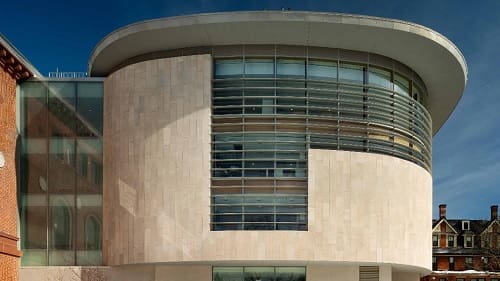
Original 1909 building reimagined as an energy-efficient, cutting-edge intellectual heart of campus for Smith’s next century
Shawmut Design and Construction, a leading $1.5 billion national construction management firm, announced that it has completed an extensive renovation and expansion to the historic Neilson Library at Smith College in Northampton, Massachusetts. The project, which broke ground in 2017, represents the college’s largest capital project of the decade.
In partnership with renowned architectural designer Maya Lin and principal architect Shepley Bulfinch, the $120 million, 200,000 square-foot project restored the building, originally opened in 1909, to bring together the library’s world-class special collections with spaces to support active learning and scholarship, entrepreneurship, and innovation. Together, with an energy-efficient design, cutting-edge technology, and flexible, collaborative workspaces, the library has transformed into the intellectual heart of the campus.
“The opening of the revitalized Neilson Library marks a pivotal point for Smith College, and we’ve been incredibly proud to be part of this transformational project,” said Ron Simoneau, Executive Vice President of Education at Shawmut Design and Construction. “Together with Maya Lin Studios and Shepley Bulfinch, our team brought to life a groundbreaking vision, one which honors Smith College’s rich history and tradition while providing bespoke capabilities that will serve generations of future students with the latest in sustainability and technology.”
The new Neilson Library incorporates the original 1909 façade and reimagines the complex as a 21st century intellectual commons. It is composed of three distinct sections: the central core as well as two new wings, dubbed “jewel boxes” for their curved, light-filled design made from a mix of masonry, wood, and glass and featuring impressive views of the campus and surrounding woods and hills.
The north wing, named for Smith’s ninth president, Ruth J. Simmons, is filled with spaces to support active learning and scholarship, entrepreneurship, and innovation. The south wing, named in honor of Smith’s eighth president, Mary Maples Dunn, brings together special collections — the Sophia Smith Collection, Rare Books, and College Archives — into one climate-controlled area, creating one-stop access to these important, rich materials.
Flexible, collaborative workspaces include the Learning Commons, Jill Ker Conway Innovation and Entrepreneurship Center, and Special Collections Seminar Room, as well as a series of classroom spaces, a reading room, contemplative study areas, sunken courtyard, and event spaces — including an accessible outdoor amphitheater with shaded seating for studying, socializing, and outdoor events.
A Digital Media Hub offers high-end studios for students to record podcasts, videos, and use other digital media; self-service labs where students can use technologies, such as spatial analysis, gaming software, survey software, and GIS; a User Experience Lab for research and usability testing; and access to large-format and 3D printers, as well as other creativity tools.
Beyond function and accessibility, the new Neilson Library is a creative work of architecture. The main entrance opens into a spacious atrium that features a stunning four-story feature oculus, a round skylight surrounded by a reflective curved wall to capture and magnify outside light throughout the building’s central core. On the outside, the glass, wood, and stone used to construct the building work with the design to promote harmony with the surrounding exterior landscape, designed by Edwina von Gal with Ryan Associates. On the fourth floor, the Skyline Terrace provides sweeping views and an outdoor patio where students can study against the backdrop of the Holyoke Range. The newly renovated Alumnae Gym, now connected to Neilson Library with an interior walkway, provides additional learning spaces that are open 24/7.
Neilson Library’s sustainability features include a high-performance building envelope, advanced daylighting strategies, and materials that promote health and wellness. Of note is the healthy materials strategy, which employs Living Building Challenge criteria. Throughout, the library incorporates materials that promote health and wellness by not containing harmful chemicals, as well as local, regional, and recycled products. The building also has the ability to become an ‘all-electric’ complex and is pursuing LEED V.4, Gold Accreditation.
A video tour of the completed building can be found here.
About Shawmut Design and Construction
Shawmut Design and Construction is a $1.5 billion national construction management firm with a reputation for completing extremely complex and logistically challenging projects for the most high-profile clients in the industry. As an ESOP (employee-owned) company, Shawmut has created a culture of ownership, proactive solution-making, and forward thinking. Eighty percent of its business comes from repeat clients, proving there is a strong focus on building lasting partnerships. Shawmut has been named Best Workplace for Women by Fortune Magazine, along with Fortune Best Workplace three years in a row, Fortune Best Workplace for Millennials, Great Place to Work’s Best Workplace for Parents, and one of America’s Best Employers by Forbes. Shawmut has 10 offices including Boston, New York, Los Angeles, Miami, Las Vegas, Chicago, and Providence. For more information, please visit www.shawmut.com.









